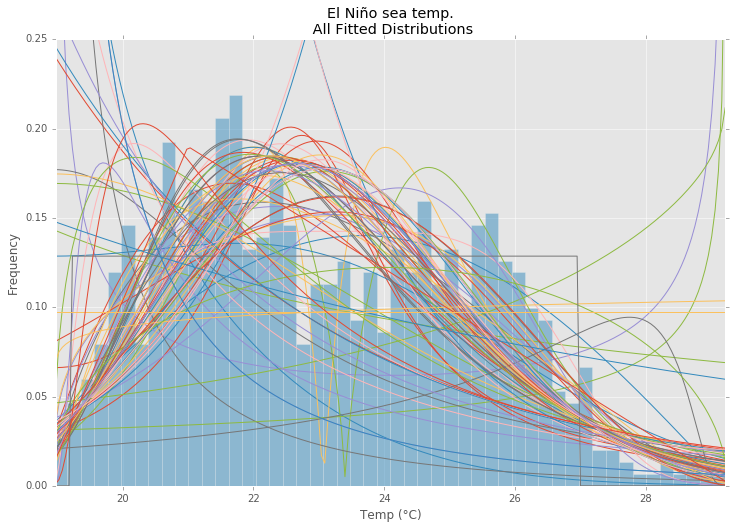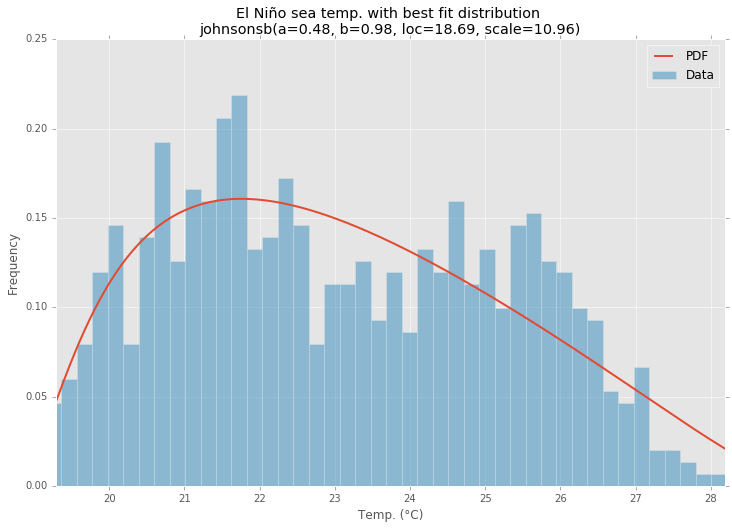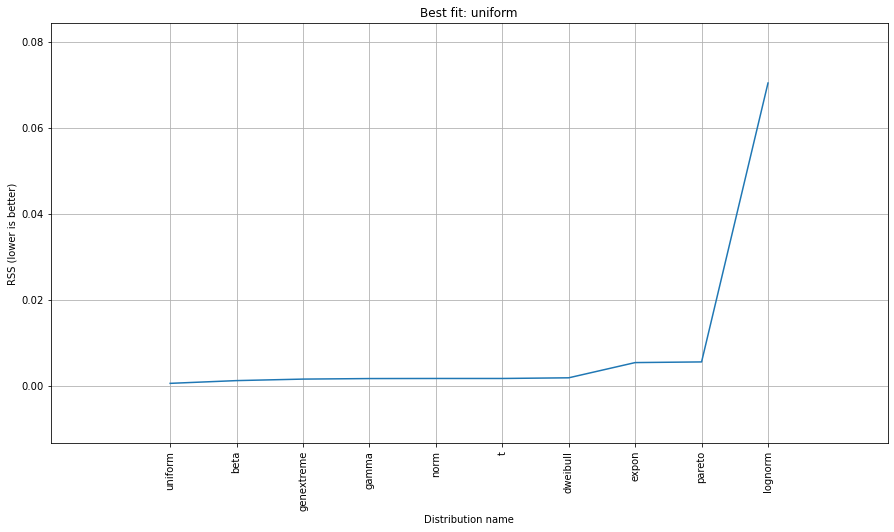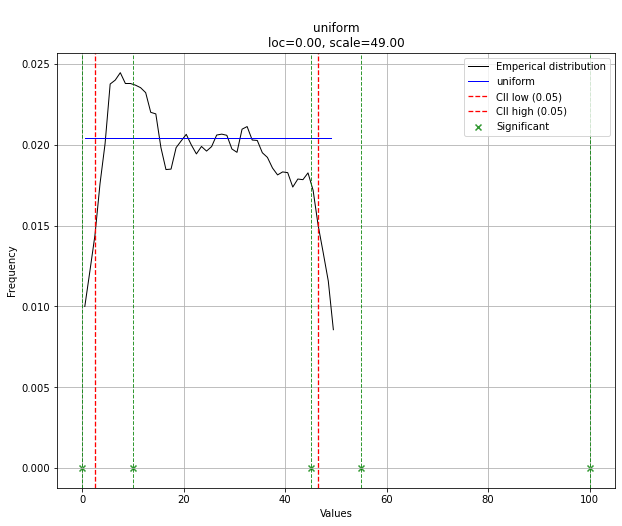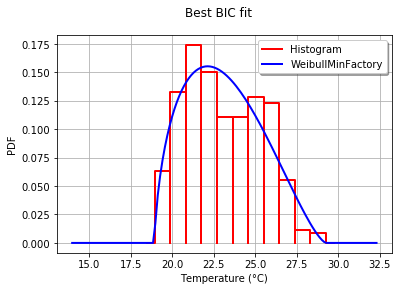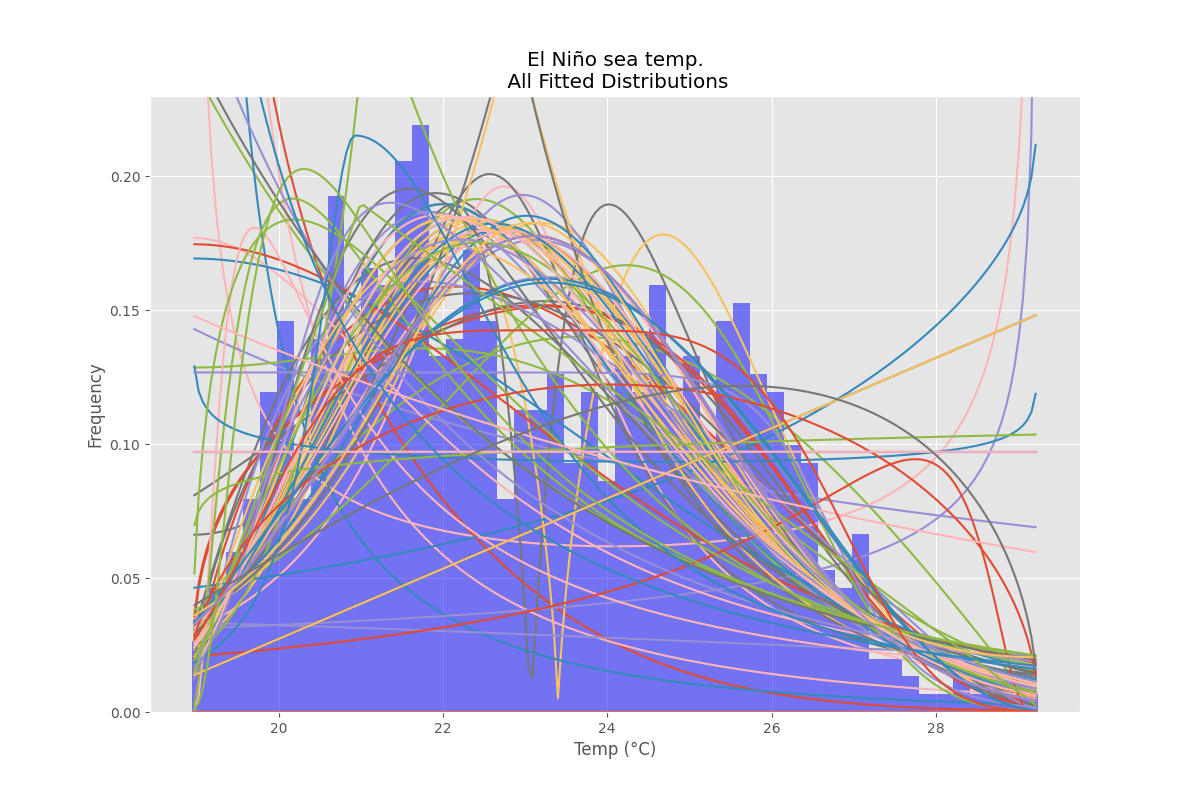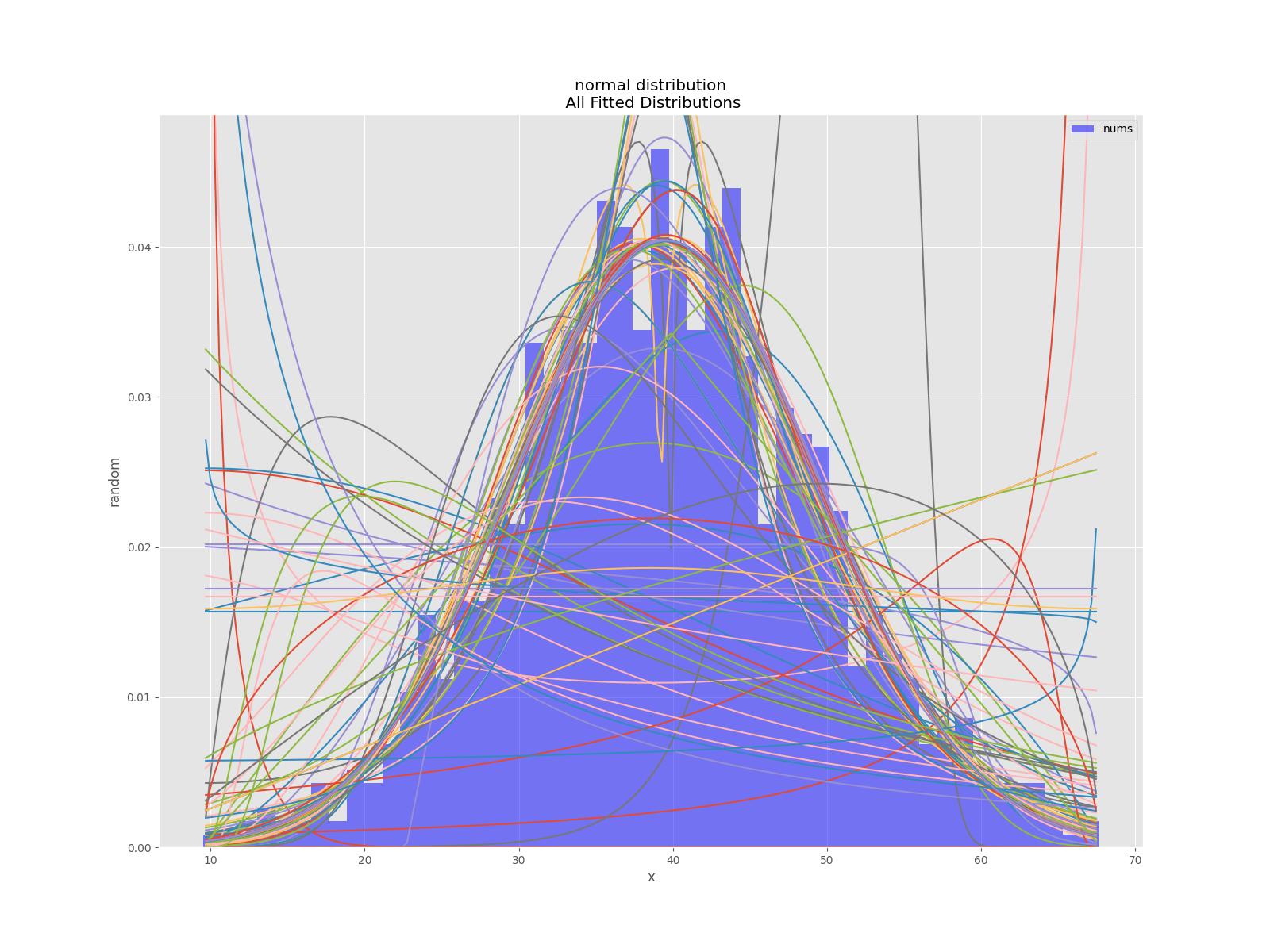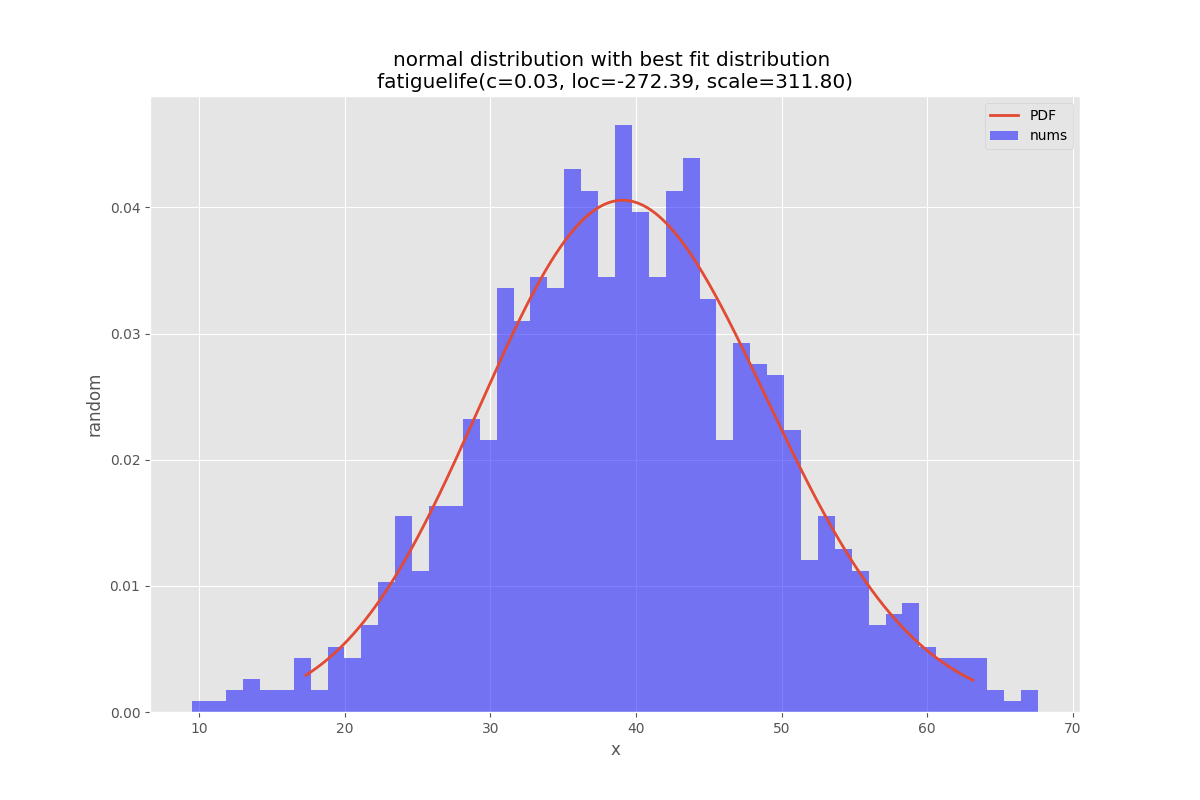I redesign the distribution function from first answer where I included a selection parameter for selecting one of Goodness-to-fit tests which will narrow down the distribution function which fits the data:
import numpy as np
import pandas as pd
import scipy.stats as st
import matplotlib.pyplot as plt
import pylab
def make_hist(data):
#### General code:
bins_formulas = ['auto', 'fd', 'scott', 'rice', 'sturges', 'doane', 'sqrt']
bins = np.histogram_bin_edges(a=data, bins='fd', range=(min(data), max(data)))
# print('Bin value = ', bins)
# Obtaining the histogram of data:
Hist, bin_edges = histogram(a=data, bins=bins, range=(min(data), max(data)), density=True)
bin_mid = (bin_edges + np.roll(bin_edges, -1))[:-1] / 2.0 # go from bin edges to bin middles
return Hist, bin_mid
def make_pdf(dist, params, size):
"""Generate distributions's Probability Distribution Function """
# Separate parts of parameters
arg = params[:-2]
loc = params[-2]
scale = params[-1]
# Get sane start and end points of distribution
start = dist.ppf(0.01, *arg, loc=loc, scale=scale) if arg else dist.ppf(0.01, loc=loc, scale=scale)
end = dist.ppf(0.99, *arg, loc=loc, scale=scale) if arg else dist.ppf(0.99, loc=loc, scale=scale)
# Build PDF and turn into pandas Series
x = np.linspace(start, end, size)
y = dist.pdf(x, loc=loc, scale=scale, *arg)
pdf = pd.Series(y, x)
return pdf, x, y
def compute_r2_test(y_true, y_predicted):
sse = sum((y_true - y_predicted)**2)
tse = (len(y_true) - 1) * np.var(y_true, ddof=1)
r2_score = 1 - (sse / tse)
return r2_score, sse, tse
def get_best_distribution_2(data, method, plot=False):
dist_names = ['alpha', 'anglit', 'arcsine', 'beta', 'betaprime', 'bradford', 'burr', 'cauchy', 'chi', 'chi2', 'cosine', 'dgamma', 'dweibull', 'erlang', 'expon', 'exponweib', 'exponpow', 'f', 'fatiguelife', 'fisk', 'foldcauchy', 'foldnorm', 'frechet_r', 'frechet_l', 'genlogistic', 'genpareto', 'genexpon', 'genextreme', 'gausshyper', 'gamma', 'gengamma', 'genhalflogistic', 'gilbrat', 'gompertz', 'gumbel_r', 'gumbel_l', 'halfcauchy', 'halflogistic', 'halfnorm', 'hypsecant', 'invgamma', 'invgauss', 'invweibull', 'johnsonsb', 'johnsonsu', 'ksone', 'kstwobign', 'laplace', 'logistic', 'loggamma', 'loglaplace', 'lognorm', 'lomax', 'maxwell', 'mielke', 'moyal', 'nakagami', 'ncx2', 'ncf', 'nct', 'norm', 'pareto', 'pearson3', 'powerlaw', 'powerlognorm', 'powernorm', 'rdist', 'reciprocal', 'rayleigh', 'rice', 'recipinvgauss', 'semicircular', 't', 'triang', 'truncexpon', 'truncnorm', 'tukeylambda', 'uniform', 'vonmises', 'wald', 'weibull_min', 'weibull_max', 'wrapcauchy']
# Applying the Goodness-to-fit tests to select the best distribution that fits the data:
dist_results = []
dist_IC_results = []
params = {}
params_IC = {}
params_SSE = {}
if method == 'sse':
########################################################################################################################
######################################## Sum of Square Error (SSE) test ################################################
########################################################################################################################
# Best holders
best_distribution = st.norm
best_params = (0.0, 1.0)
best_sse = np.inf
for dist_name in dist_names:
dist = getattr(st, dist_name)
param = dist.fit(data)
params[dist_name] = param
N_len = len(list(data))
# Obtaining the histogram:
Hist_data, bin_data = make_hist(data=data)
# fit dist to data
params_dist = dist.fit(data)
# Separate parts of parameters
arg = params_dist[:-2]
loc = params_dist[-2]
scale = params_dist[-1]
# Calculate fitted PDF and error with fit in distribution
pdf = dist.pdf(bin_data, loc=loc, scale=scale, *arg)
sse = np.sum(np.power(Hist_data - pdf, 2.0))
# identify if this distribution is better
if best_sse > sse > 0:
best_distribution = dist
best_params = params_dist
best_stat_test_val = sse
print('\n################################ Sum of Square Error test parameters #####################################')
best_dist = best_distribution
print("Best fitting distribution (SSE test) :" + str(best_dist))
print("Best SSE value (SSE test) :" + str(best_stat_test_val))
print("Parameters for the best fit (SSE test) :" + str(params[best_dist]))
print('###########################################################################################################\n')
########################################################################################################################
########################################################################################################################
########################################################################################################################
if method == 'r2':
########################################################################################################################
##################################################### R Square (R^2) test ##############################################
########################################################################################################################
# Best holders
best_distribution = st.norm
best_params = (0.0, 1.0)
best_r2 = np.inf
for dist_name in dist_names:
dist = getattr(st, dist_name)
param = dist.fit(data)
params[dist_name] = param
N_len = len(list(data))
# Obtaining the histogram:
Hist_data, bin_data = make_hist(data=data)
# fit dist to data
params_dist = dist.fit(data)
# Separate parts of parameters
arg = params_dist[:-2]
loc = params_dist[-2]
scale = params_dist[-1]
# Calculate fitted PDF and error with fit in distribution
pdf = dist.pdf(bin_data, loc=loc, scale=scale, *arg)
r2 = compute_r2_test(y_true=Hist_data, y_predicted=pdf)
# identify if this distribution is better
if best_r2 > r2 > 0:
best_distribution = dist
best_params = params_dist
best_stat_test_val = r2
print('\n############################## R Square test parameters ###########################################')
best_dist = best_distribution
print("Best fitting distribution (R^2 test) :" + str(best_dist))
print("Best R^2 value (R^2 test) :" + str(best_stat_test_val))
print("Parameters for the best fit (R^2 test) :" + str(params[best_dist]))
print('#####################################################################################################\n')
########################################################################################################################
########################################################################################################################
########################################################################################################################
if method == 'ic':
########################################################################################################################
######################################## Information Criteria (IC) test ################################################
########################################################################################################################
for dist_name in dist_names:
dist = getattr(st, dist_name)
param = dist.fit(data)
params[dist_name] = param
N_len = len(list(data))
# Obtaining the histogram:
Hist_data, bin_data = make_hist(data=data)
# fit dist to data
params_dist = dist.fit(data)
# Separate parts of parameters
arg = params_dist[:-2]
loc = params_dist[-2]
scale = params_dist[-1]
# Calculate fitted PDF and error with fit in distribution
pdf = dist.pdf(bin_data, loc=loc, scale=scale, *arg)
sse = np.sum(np.power(Hist_data - pdf, 2.0))
# Obtaining the log of the pdf:
loglik = np.sum(dist.logpdf(bin_data, *params_dist))
k = len(params_dist[:])
n = len(data)
aic = 2 * k - 2 * loglik
bic = n * np.log(sse / n) + k * np.log(n)
dist_IC_results.append((dist_name, aic))
# dist_IC_results.append((dist_name, bic))
# select the best fitted distribution and store the name of the best fit and its IC value
best_dist, best_ic = (min(dist_IC_results, key=lambda item: item[1]))
print('\n############################ Information Criteria (IC) test parameters ##################################')
print("Best fitting distribution (IC test) :" + str(best_dist))
print("Best IC value (IC test) :" + str(best_ic))
print("Parameters for the best fit (IC test) :" + str(params[best_dist]))
print('###########################################################################################################\n')
########################################################################################################################
########################################################################################################################
########################################################################################################################
if method == 'chi':
########################################################################################################################
################################################ Chi-Square (Chi^2) test ###############################################
########################################################################################################################
# Set up 50 bins for chi-square test
# Observed data will be approximately evenly distrubuted aross all bins
percentile_bins = np.linspace(0,100,51)
percentile_cutoffs = np.percentile(data, percentile_bins)
observed_frequency, bins = (np.histogram(data, bins=percentile_cutoffs))
cum_observed_frequency = np.cumsum(observed_frequency)
chi_square = []
for dist_name in dist_names:
dist = getattr(st, dist_name)
param = dist.fit(data)
params[dist_name] = param
# Obtaining the histogram:
Hist_data, bin_data = make_hist(data=data)
# fit dist to data
params_dist = dist.fit(data)
# Separate parts of parameters
arg = params_dist[:-2]
loc = params_dist[-2]
scale = params_dist[-1]
# Calculate fitted PDF and error with fit in distribution
pdf = dist.pdf(bin_data, loc=loc, scale=scale, *arg)
# Get expected counts in percentile bins
# This is based on a 'cumulative distrubution function' (cdf)
cdf_fitted = dist.cdf(percentile_cutoffs, *arg, loc=loc, scale=scale)
expected_frequency = []
for bin in range(len(percentile_bins) - 1):
expected_cdf_area = cdf_fitted[bin + 1] - cdf_fitted[bin]
expected_frequency.append(expected_cdf_area)
# calculate chi-squared
expected_frequency = np.array(expected_frequency) * size
cum_expected_frequency = np.cumsum(expected_frequency)
ss = sum(((cum_expected_frequency - cum_observed_frequency) ** 2) / cum_observed_frequency)
chi_square.append(ss)
# Applying the Chi-Square test:
# D, p = scipy.stats.chisquare(f_obs=pdf, f_exp=Hist_data)
# print("Chi-Square test Statistics value for " + dist_name + " = " + str(D))
print("p value for " + dist_name + " = " + str(chi_square))
dist_results.append((dist_name, chi_square))
# select the best fitted distribution and store the name of the best fit and its p value
best_dist, best_stat_test_val = (min(dist_results, key=lambda item: item[1]))
print('\n#################################### Chi-Square test parameters #######################################')
print("Best fitting distribution (Chi^2 test) :" + str(best_dist))
print("Best p value (Chi^2 test) :" + str(best_stat_test_val))
print("Parameters for the best fit (Chi^2 test) :" + str(params[best_dist]))
print('#########################################################################################################\n')
########################################################################################################################
########################################################################################################################
########################################################################################################################
if method == 'ks':
########################################################################################################################
########################################## Kolmogorov-Smirnov (KS) test ################################################
########################################################################################################################
for dist_name in dist_names:
dist = getattr(st, dist_name)
param = dist.fit(data)
params[dist_name] = param
# Applying the Kolmogorov-Smirnov test:
D, p = st.kstest(data, dist_name, args=param)
# D, p = st.kstest(data, dist_name, args=param, N=N_len, alternative='greater')
# print("Kolmogorov-Smirnov test Statistics value for " + dist_name + " = " + str(D))
print("p value for " + dist_name + " = " + str(p))
dist_results.append((dist_name, p))
# select the best fitted distribution and store the name of the best fit and its p value
best_dist, best_stat_test_val = (max(dist_results, key=lambda item: item[1]))
print('\n################################ Kolmogorov-Smirnov test parameters #####################################')
print("Best fitting distribution (KS test) :" + str(best_dist))
print("Best p value (KS test) :" + str(best_stat_test_val))
print("Parameters for the best fit (KS test) :" + str(params[best_dist]))
print('###########################################################################################################\n')
########################################################################################################################
########################################################################################################################
########################################################################################################################
# Collate results and sort by goodness of fit (best at top)
results = pd.DataFrame()
results['Distribution'] = dist_names
results['chi_square'] = chi_square
# results['p_value'] = p_values
results.sort_values(['chi_square'], inplace=True)
# Plotting the distribution with histogram:
if plot:
bins_val = np.histogram_bin_edges(a=data, bins='fd', range=(min(data), max(data)))
plt.hist(x=data, bins=bins_val, range=(min(data), max(data)), density=True)
# pylab.hist(x=data, bins=bins_val, range=(min(data), max(data)))
best_param = params[best_dist]
best_dist_p = getattr(st, best_dist)
pdf, x_axis_pdf, y_axis_pdf = make_pdf(dist=best_dist_p, params=best_param, size=len(data))
plt.plot(x_axis_pdf, y_axis_pdf, color='red', label='Best dist ={0}'.format(best_dist))
plt.legend()
plt.title('Histogram and Distribution plot of data')
# plt.show()
plt.show(block=False)
plt.pause(5) # Pauses the program for 5 seconds
plt.close('all')
return best_dist, best_stat_test_val, params[best_dist]
then continue to make_pdf function to get the selected distribution based on the your Goodness-of-fit test/s.

